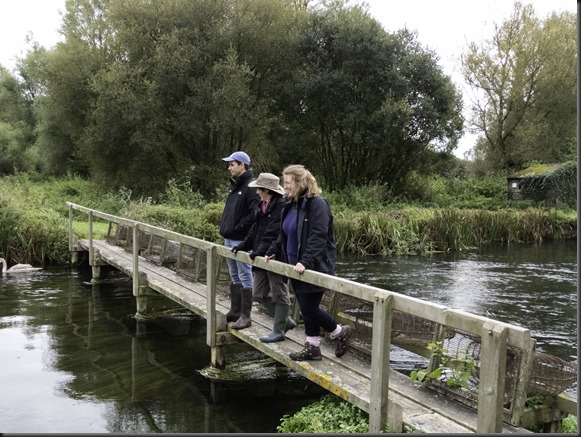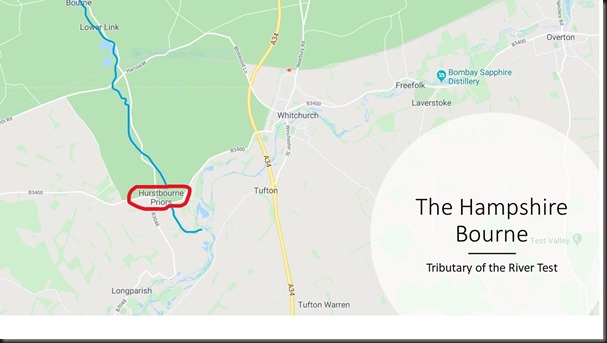I was impressed recently, by Alison Graham-Smith , a Lead Advisor on conservation and Land Management for ‘Natural England’ in Hampshire, who had read Harry Plunket Greene’s book “Where the bright waters meet”. I was all the more impressed because she is not a fly fisher. I asked her how she had come to read the book, and why. In her reply she explained that it was important as a conservationist to have read the history and the descriptions of Hampshire, before she could claim to be equipped to restore that environment.
Mark, Alison and Sam : Catchment sensitive farming advisors from Natural England, surveying the River Test at Leckford in October
Impressive, don’t you think?
The conversation swished around in my head on that trip, and so when I returned I re-read this old book, and I thought I would share some of it here. It occurred to me that a whole bunch of fishermen have probably heard of the man, and the book, but in an age where few people actually read, I suspect many of us know a lot less about the book than Alison does. I suppose you could be forgiven for that: There was a fair bit of flyfishing literature around at that time, as well as famous flyfishing personalities ‘on the go’, and besides, a lot of these books have lost their dust jackets, and they look faded and smell a bit funny.
But Imagine meeting a lady, who doesn’t fly fish, and have her trounce you in her knowledge of a famous fly-fishing book!
I thought I would rush to your rescue on this front, so here are some interesting facts about the man and the book:
Within those dusty pages are some treasures, and you might find some of this interesting.
When Plunket Greene was born in 1865, GEM Skues was a 10 yr old boy, and FM Halford was 21 years of age. When the Halford/Skues fued over dry fly vs nymph got going, Plunket Greene would have been in his late thirties, and had just moved from London to live in the village of Hurstbourne Priors on the banks of the Hampshire Bourne. Unless I missed it, he doesn’t even give a passing mention to the feud or the two luminaries of the time!
Frank Sawyer had not yet been borne, and across the Atlantic Theodore Gordon of New York had been writing for ten years since receiving a letter and envelope from Halford containing his first dry flies. It would be another ten years before George Le Branche wrote “Dry fly and fast water” and Ray Bergmann’s “Trout” would be written only 2 years after Plunket Greene’s death.
Harry Plunket Greene
Plunket Greene writes in his opening chapter about how he discovered the Bourne. He goes on to write about the wildlife of the valley, and devotes a chapter to the “Iron Blue”. The crux of his message comes in the chapter “ Tragedy of the Bourne”, in which he describes the overstocking of 1905. He opens the next chapter with the words “I prefer to pass over 1906 in silence”, giving weight to the tragedy which he experienced. He writes too of the demise of the original genetics, and of the trout with black backs, a condition he believed they obtained from the tar that leached off the newly tarred roads into the stream. He laments the loss of the silver fish. But his fishing stories do continue through 1910 and beyond, covering days on the Kennet and the Test, and of course the Bourne, and Blagdon.
Harry didn’t tie flies, but he was somewhat obsessed with the Iron Blue Dun.
The Iron Blue
He did fish Blagdon reservoir quite extensively, and people don’t mention that when talking of this book. In fact who knew that Blagdon existed in 1905! Commentators are inclined to make out that it is a purist tome dedicated to the Hampshire Bourne. It is that, but it wanders off into discussions about introducing lawn tennis to Germany, running over dogs, card tricks, games of cricket, and lots of singing.
Singing was of course Harry’s career, and the stories of his touring and putting on “gigs” are scattered about the book. He talks a great deal about his companions on the river, and elsewhere, and it is clear that he was a gregarious fellow. In fact he enjoyed a hot crowded room, and lots of onlookers!
He was a large and imposing man, and reading of him, it could be said that he was “showy”. But here is a quote from his book which speaks to an underlying authenticity in that showiness, and which I think, warrants much thought:
“…..true magnetism and playing to the gallery, though they may have a common ancestor, are as far as the poles apart in the ethics of performance. The one is unconscious, compelling and incomparably precious, the other studied,opportunistic, cheap and nasty”
In reading the book, I sense he didn’t suffer fools, and he makes some cutting remarks about people with questionable intentions.
He was also a nostalgic, and was possessed with an acute and biting appreciation of the countryside and the environment. And this was in 1924! Not unlike Frank Sawyer, Plunket Greene acknowledges that he was complicit, even if reluctantly so, in the stocking his trout stream ( the Hampshire Bourne in his case, The Hampshire Avon in Sawyer’s) , with introduced fish, which displaced the wild fish. He berates himself for the stocking, and is scarred by the guilt of having done so, having learned that the preservation of the natural environment was, with the wisdom of hindsight, the true solution.
What was ironic about this aspect, is that while I was in the UK this year, news broke of how many TONS of trout are stocked into the Test annu
ally. Remember that the Hampshire Bourne is a tributary of the Test.
The Bourne, a tributary of the Test
So what this tells me, is that while fly fishermen wax lyrical about “The Bright Waters” and leave fly boxes at the grave of Harry Plunket Greene, we seem, as a collective to be obsessed with catching fish, even at cost to the environment, and oblivious to his message and his pleas.
Considering the era in which the book was written, it strikes me that he writes with such nostalgia about “The old days”. It also strikes me how environmentally aware he was. In my opinion there is much to be gained from these old books. It places modern fly fishing and conservation topics in context, and it also serves to remind us that not a whole lot has changed. Reading this stuff might also help us to avoid repeating old mistakes, be they ones relating to trout stalking, or how to care for our streams and the trout in them.
I end with the last lines of this lovely book:
“But somewhere, deep down, I have a dim hope that one night the fairy Godmother will walk along the tarry road and stop on the bridge and listen, and send a message to me in the dark; and that when the mists begin to lift, and the poplars to shiver and the cock pheasants crow in the beech-woods, the little Bourne will wake and open her eyes and find in their bosom again the exiles that she had thought were gone for good – the silver trout, and the golden gravel,and the shrimp and the duns- and smell the dust of the road, and see the sun once more, and the red and white cows in the grass, and the yellow buttercups in the meadow and the blue smoke of the cottages against the black elms of the Andover hill –and me too, perhaps, kneeling beside her as of old and watching the little iron-blue, happy, laughing, come bobbing down to me under the trees below the Beehive bridge on the Whitchurch road.
The end”
Post script from the fairy godmother: Well Harry….a message for you …..take a look here…River restoration….




One Response